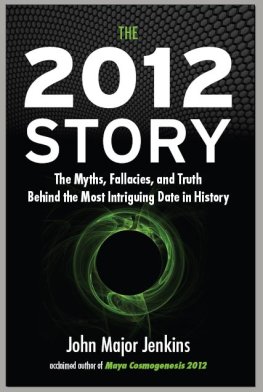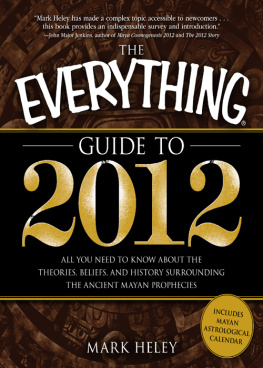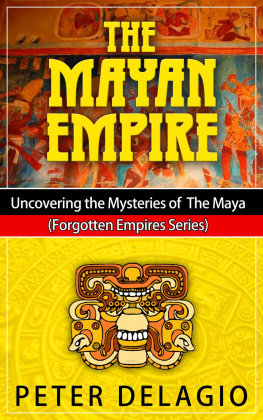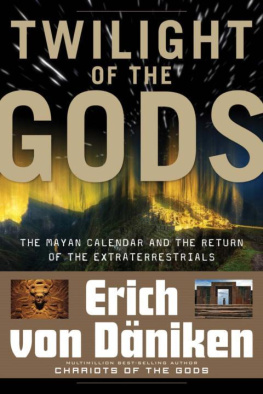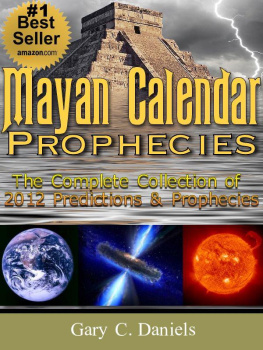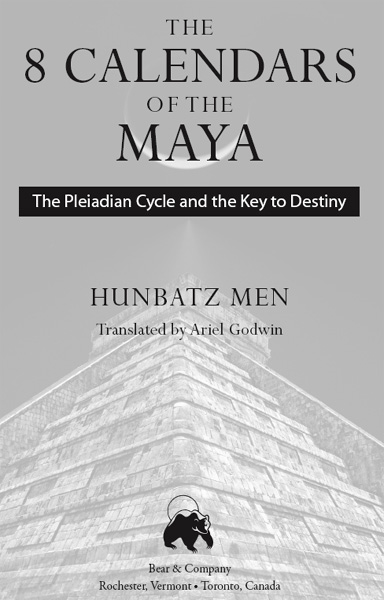
THE
8 CALENDERS
OF THE
MAYA

As a traditional Mayan teacher and daykeeper, Hunbatz Men sheds light on the great mystery of Maya/Cherokee oral traditionthe sacred relationship between Earth and the Pleiades. In our sacred tradition, our lives synchronize with the whole cosmos because our Sun is part of the Pleiadian star system. When our hearts are open to our cosmic home, we resonate with the skys heart, Alcyone, the central star of the Pleiades. This is what I was taught by my Cherokee grandfather Hand, and now Hunbatz Men elucidates the Tzekeb, the calendars of the Pleaidian Suns. This is a must read for anyone who wonders why humans on Earth feel they are in touch with the Pleiadians.
BARBARA HAND CLOW, AUTHOR OF
THE MAYAN CODE: TIME ACCELERATION
AND THE AWAKENING OF THE WORLD MIND
AND THE PLEIADIAN AGENDA: A NEW
COSMOLOGY FOR THE AGE OF LIGHT
CONTENTS
ONE
TWO
THREE
FOUR
FIVE
SIX
SEVEN
Afterword

This is the memory of the things that happened and they did. Now all is passed. They speak with their own words and thus not all is understood of its meaning; but rightly as it all happened, so it is written. Now again, it all will be very well explained. And perhaps it will not be bad.... Truly many were their real Men. Not in order to sell betrayals did they like to be united some with others; but all that is herein contained or how much needs to be explained is not yet apparent. Those who know it come from our great lineage, that of the Mayan men. These will understand the meaning of what is in here when they read it. And then they will see it and then explain it, and then the obscure signs of the Katn will be clear. It is so because they are the sacerdotes. The sacerdotes ended, but not their name, ancient as they are.
CHILAM BALAM OF CHUMAYEL,
FROM THE SPANISH TRANSLATION
BY ANTONIO MEDIZ BOLIO
FOREWORD
The great value of this work resides in its well-documented content and the authors authenticity as a modern Mayan hau k in, a traditional Mayan teacher, whose wisdom emerges from his own experience. Hunbatz Men is a true Mayan shaman and daykeeperan authority on the history, chronology, calendars, and cosmic knowledge of the Mayan civilization. He was born in Wenkal, on the Yucatn Peninsula, in Mexico, and became a disciple of the greatest contemporary champion of Mayan values, Maestro Domingo Martnez Paredes (18991983), a professor of the Mayan language at the Universidad Nacional Autnoma de Mxico (National Autonomous University of Mexico) and the author of many works that have brought to light the transcendent nature of the cultural values of this great indigenous civilization.
The study of the Mayan astronomical calendars of pre-Columbian America shows that in the traditional Mayan culture the computation of time was not determined by simple commercial or civil requirements. There was a much loftier goal: to synchronize the lives of human beings and societies to the great cosmic pulsation, to the rhythm of the seasons, and to the other cycles that dictate changes on Earth. Thus by following this rhythm of the universe (the beats of the skys heart, as the Mayan Popol Vuh describes it), whether through lunar, solar, planetary, stellar, or galactic biorhythms, human beings could avoid all manner of decadence. They could keep themselves in harmony with the universal constant and expand their individual beings far beyond those paltry syllogistic reasonings that fail to achieve a profound observation of certain simple but vital facts.
This cosmic measuring, and its corresponding human synchronization, required an identification of the individual, society, nature, and cosmosa true and complete yok hah Maya (Mayan yoga). It was a synthetic science, schematized in that invaluable indigenous archeometer: the Mayan astronomical calendars. Here was the key for curing all illnesses and for regenerating the human species, living according to the rules of life, those golden rules that humans did not invent, but rather discovered.
This work by Hunbatz Men complements certain other works published on the same topic, while at the same time enriching them by filling a disconcerting void in the study of the calendars. For this reason, I am pleased to welcome and encourage Hunbatz Men as he continues in the noble task he has set for himself: recovering the legacy of the values of our indigenous races. Indigenous Americaour silenced culture celebrates the publication of this valuable fruit of the Mayan astronomical calendars. Congratulations to Hunbatz Men for such a worthy endeavor, and salutations to all those who preserve faith in our peoples and in the future of our beloved American continent.
IN LAKECH,
SAT ARHAT DOMINGO DIAS PORTA
The Venerable Sat Arhat Domingo Dias Porta is a Mayan elder, born and educated in Venezuela. In the 1980s he founded the Movement for the American Indian Solar Cultures.
INTRODUCTION
Our Mayan ancestors were true sages, not simple speculators. They developed an elaborate set of principles that they applied to their religion, their philosophy, their sciences, their architecture, their medicine indeed, all aspects of their culture.
These principles of the ancient Maya arose out of a single spiritual conception: that the entirety of the cosmos is permeated by sacred energy, and as the cosmos unfolds in countless permutations it constantly reveals the sacredand thus determines everyday life. In the Mayan way of thinking, human beings are harmonized with divine energy, such that the divine manifests in the myriad forms and beings of the physical world, the world of nature, while the physical world and all its manifestations in nature are reflections of the divine. Being master astronomers, the Mayan sages naturally extended this conception throughout space, such that the whole universejust like the individual human beingwas perceived as a manifestation of divine energy, constantly moving and changing.
Such knowledge was acquired by the ancient Maya through their meticulous observation of nature, which they regarded as their mother and guide. She was the goddess IxmucaneMother Earthone of the thirteen Mayan gods who created the hombres de maiz, people of corn, or human beings. She ground yellow, white, red, and black corn and prepared nine different drinks with this mixture. Strength and endurance came from this nourishment, creating the muscles and vigor of the human being, according to the Popol Vuh. Thus Mother Earths function as a creative force was recognized in the unfolding of the essential processes of life.
Being an expression of the divine, nature (just like the human being) is subject to certain sacred laws, said the Maya of old. They developed an advanced mathematics in which numbers did not specifically relate to quantity, as is often assumed by the modern-day, materially obsessed world; all numbers were expressions of the different frequencies and tones of the divine. So, for example, in the Mayan language the Moon was called U, Uc, or Uh; it possessed the numerical value of 7. This number ruled women as well as the cycles of generation and conception, since according to the Mayan calendar it was possible to know when one might conceive a son or a daughter. Likewise, by following the lunar cycles, a woman would know the days on which she would not conceive, thereby regulating population in times when food and resources were scarce. This number also represented, among other things as we will see later, the seven powers, or brains, of the human being.
Next page

